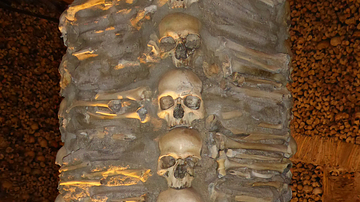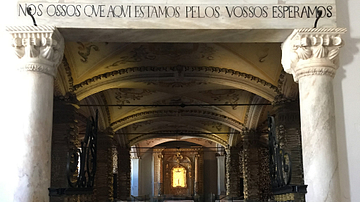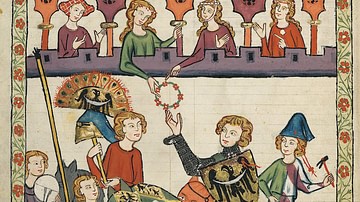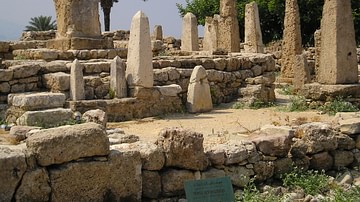Search
Search Results

3D Image
Chapel Detail in Chillon Castle
The Chapel Saint-Georges was the private chapel for the Catholic dukes of Savoy in the Middle Ages. Although the chapel was no longer used after the Swiss Reformation in the 16th century CE, the room served as an attic and powder deposit...

Article
The Six Wives of Henry VIII
In his search to secure the continuation of the Tudor line, Henry VIII of England (r. 1509-1547 CE) married an incredible six times. Some marriages were the result of passion while others were arranged for political reasons. One divorce caused...

Article
On the Path of Early Christianity in Marseille
Today, Marseille is known more for its modern history – World War II, North African immigration, and, of course, the rousing choruses of France's national anthem, La Marseillaise. Yet it is also one of France's most ancient cities, one rich...

Image
Capela dos Ossos Bone Pillar
Pillar at the Capela dos Ossos (Chapel of Bones), Evora, Portugal showing human skulls and bones. The Chapel of Bones was constructed by Franciscan monks in the late 16th century CE. Photo taken 2016 CE.

Image
Byzantine Church Pulpit from Petra
Byzantine church pulpit, found broken into pieces at its original location in the "Blue Chapel" on the northern ridge of the Petra city center, Jordan, dating from the 6th century. Petra was a Bishopric See in the Byzantine Empire. The pulpit...

Image
Capela dos Ossos, Evora, Portugal
Inscription above the door to Capela dos Ossos (Chapel of Bones), Evora, Portugal. The Chapel of Bones was constructed by Franciscan monks in the late 16th century CE. Photo taken 2017 CE.

Definition
Medieval Chivalry
In medieval Europe, a code of ethics known as chivalry developed which included rules and expectations that the nobility would, at all times, behave in a certain manner. Chivalry was, in addition, a religious, moral and social code which...

Definition
Prince Henry the Navigator
Prince Henry the Navigator (aka Infante Dom Henrique, 1394-1460) was a Portuguese prince who famously helped capture the North African city of Ceuta, sponsored voyages of exploration with the aim of building colonies in the North Atlantic...

Definition
Middle Kingdom of Egypt
The Middle Kingdom (2040-1782 BCE) is considered ancient Egypt's Classical Age during which it produced some of its greatest works of art and literature. Scholars remain divided on which dynasties constitute the Middle Kingdom as some argue...

Definition
Phoenician Architecture
Phoenician architecture is typified by large temples with double-columned facades approached by a short staircase, enclosed sacred spaces containing cube-like and open-fronted shrines, and such large-scale engineering projects as dams and...